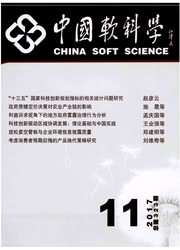

 中文摘要:
中文摘要:
基于2008--2013年中国上市公司数据,运用广义倾向得分匹配方法(GPS)详细刻画了政府补贴对企业创新投入和产出之间的因果效应。结果发现GPS方法处理内生性关联后得到的最优补贴力度显著低于POLS、FE模型及TCIBIT估计结果;因果效应在任意补贴力度区间内均大于零,意味着政府补贴能够显著促进企业研发创新行为;政府补贴与企业研发创新投入和产出之间均呈倒“U”型关系表明,只有适度的政府补贴才能产生最大的创新激励效应,补贴过高则会弱化这一作用。
 英文摘要:
英文摘要:
Based on the samples of listed companies in Shanghai and Shenzhen Stock Exchange from 2008 to 2013, this paper analyzes the causal effects of government subsidies on enterprise innovation input and output by using the generalized propensity score matching(GPS) method. The results show that the optimal subsidy obtained by dealing with endogeneity using GPS method is significantly lower than the result of Pooled OLS, Fixed Effect and TOBIT model. The causal effects are greater than ze- ro in any subsidies scope, indicating that government subsidies can significantly promote enterprise in- novation. And the distribution curve of the effects on enterprise innovation input and output appears as inverse U shape curve, showing that only the moderate intensity of government subsidies is most contributive to the increase of innovation, namely too high intensity of subsidies is not beneficial to the increase of enterprise innovation.
 同期刊论文项目
同期刊论文项目
 同项目期刊论文
同项目期刊论文
 期刊信息
期刊信息
